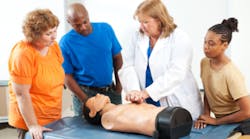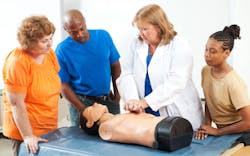By Patti DiGangi, RDH, BS
For the first-time, CPR/BLS certification classes are being given at RDH Under One Roof. These classes will use the American Heart Association (AHA) HeartCode BLS Blended learning system.
According to AHA, less than 8 percent of people who go into cardiac arrest survive. With changing risk profiles for younger people and an aging society, the possibility of performing CPR in your office is increasing.
As health-care professionals required to maintain current CPR/BLS certification, we know this. Classes prepare us through new guidelines and technology. Some powerful technology apps can help at the most important times. Apps can help coach through stressful situations.
CPR guidelines update
It can feel as if every time you take a CPR class, the guidelines have changed. This is not quite true. New CPR guidelines are based on the latest scientific data from the previous five years. For example, the 2010 recommendations led to a major shift moving from ABC to CAB methodology. This change focused more on the chest compressions to keep blood moving to prevent brain damage rather than delivering rescue breaths.
The scientific data includes the behavioral data of what individuals actually do under the stress of emergencies. The 2015 update has placed limits on how fast and deep compressions should be performed. Assistance in performing needed skills is further enhanced through technology both during and after the classes.
Classroom technology changes
Blended learning for CPR certification has been available for many years. Blended learning uses online technology not only to supplement but also to transform and improve the learning process. Successful blended learning accommodates for varying learning styles and in different environments.
The AHA HeartCode BLS is the online portion of BLS blended learning. It uses a variety of eLearning assets such as dramatizations, e-simulations, animations, self-directed learning, and interactive activities to teach students BLS knowledge and skills. After completing the online portion, students must attend a structured, instructor-led and hands-on session that focuses on meaningful skills practice, debriefing, team scenarios, and skills testing.
This is the method we will use in August at RDH Under One Roof.
Measuring effective compressions
Even for seasoned health care professionals, it’s hard to know if you are pushing hard enough and fast enough to meet current guidelines for compression rate and depth. A key recommendation of the 2015 AHA Guidelines for CPR) and Emergency Cardiovascular Care is to minimize interruptions in CPR.
ZOLL Medical Corporation is providing their Real CPR Helpfor our UOR classes. Using accelerometer technology, a sensor inside ZOLL’s CPR electrodes captures the rate and depth of each compression. Once the electrodes are placed on the patient, the person providing CPR presses on the clearly marked hand placement indicator that covers the sensor. The information captured is sent to the defibrillator, where it is immediately processed and provided in real time to the rescuer.
Apps for after the classes
In the CPR skills portion, training for the compressions is practiced to the reflex level. This is important because our brains need to be available for the changing circumstances that occur in rescue situations. The challenge is degradation of skills. It is estimated that your skills start degrading within six weeks of class completion.
The AHA still encourages us to use the song, “Stayin’ Alive,” to keep the right pace for compressions. Although I love that 1977 Bee Gees song, I doubt I remember the words or beat that well. We need better options.
This is when phone apps can help. Most of all us have our phones close by and ready to use. Some of the options are:
- AHA Guidelines On-The-Go by American Heart Association.
- CPR Tempo provides audio and visual cues to aid the timing of chest compressions during CPR.
- CPR Timer helps you to keep the compression rhythm during CPR.
All of these app links for iPhones are also available in Android.
You make the difference
When a person has a cardiac arrest, survival depends on immediately getting CPR from someone nearby. Almost 90% of people who suffer out-of-hospital cardiac arrests die. CPR, especially if performed in the first few minutes of cardiac arrest, can double or triple a person’s chance of survival. We make the difference.
For more information about the course at RDH Under One Roof, click here. The course does require that the AHA online didactic be completed, and proof of completion of the online portion of the course is required.
Patti DiGangi, RDH, BS is an international speaker passionate about prevention. She is the author of the DentalCodeology series of bite-size books for busy people including A Gingivitis Code Finally! Patti is also a long-time American Heart Association Certified BLS/CPR Instructor.








